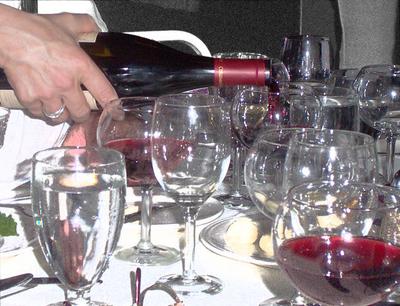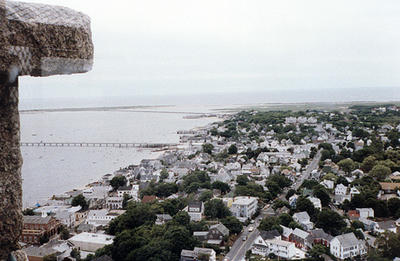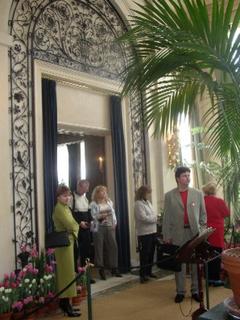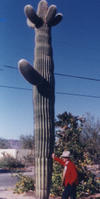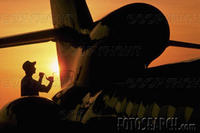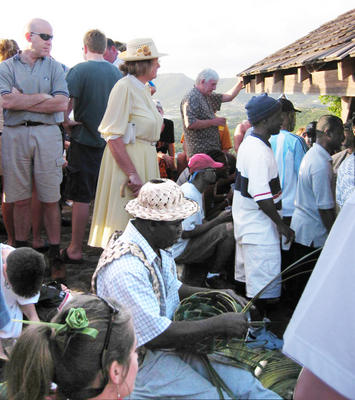
April L. Dowd photos
ENGLISH HARBOUR, Antigua -- It had been a long time since she had been to Shirley Heights for a Sunday steel drum orchestra concert. Lavinia wanted to make a good impression on anyone who might notice her.
Yes, the lemon yellow frock, she thought. And the matching yellow picture hat. They would be perfect.
She missed Lionel. He hadn't been particularly fond of the steel drums -- "Bloody noisy cans," he'd called them in his grumpily good-natured way -- but he was kind enough to take her up to the old British fort every few weeks. He contented himself with the spectacular view of English Harbour far down below while she was busy enjoying the music and the visitors who flocked to Antigua in the early months each year to luxuriate in the brilliant sunshine when coverlets of snow were the order of the day back home in Britain and Australia and the United States.
It had been more than a year since Lionel had passed on, but a return to England still was out of the question even at her advanced age. A life spent mostly in the British West Indies as the wife of a foreign service official didn't exactly make one want to move on, even if a spouse of nearly 50 years no longer was here to share the daily adventures.
Lavinia had finally grown restless and felt the need of an outing to a familiar spot. Her driver parked the car at the foot of the path leading up to the ruins of the old stone observation post that had been the guardian of the British Navy's Caribbean fleet under the iconic 18th century naval hero Horatio Nelson.
Lavinia paid her $4 US -- odd, she thought, how the Yankee dollar had become the common currency in the Caribbean -- to the polite young men in the wooden guard shack, receiving in exchange an entry ticket that also entitled her to one cocktail or a beer in the former fort building that now served as a pub. As if that would entice her.
Lavinia skirted the building and made her way along the steep rock ledge where the plateau fell sharply away. She wanted to stake out a spot next to the covered pavilion where tourist children already were performing those little show-off dances children often do when music is played in public places. Meanwhile, their suburned parents were queing up at the various rudimentary barbecue stands that dotted the grounds.
As the rhythm of the steel drums gathered momentum and the rays of the descending sun glanced off the mountains guarding English Harbour, Lavinia swayed almost imperceptibly to the beat while less inhibited visitors clapped hands and wiggled hips in time to the sensuous music. And, she thought of Lionel.
Of course, all this is mostly supposition.
The crowd was real and the details described are real, and the woman in the lemon yellow dress and hat was most assuredly very real the evening I stood on Shirley Heights, even though she seemed to have a mystical knack of never being in a clear line of sight for the camera.
I could only imagine the details of her life, loathe as I was to intrude on her obvious pleasureable solitude in the midst of a crowd of jabbering Yanks, Aussies and Britions, most of them jarringly dressed in shorts or jeans and T-shirts and athletic shoes of every hue.
Her ensemble was too calculated, too British in the way we have come to know over the years. But she was so perfect in so many ways, a sharp reminder that Antigua remains a British island in ways at once obvious and imperceptible despite being granted its independence in 1981.
Begin with the place names -- English Harbour, Nelson's Dockyard National Park, Clarence House, Shirley Heights, Dow's Hill Interpretation Center, Fort Berkeley and the tiny communities of Gray's Farm, All Saints, Falmouth Harbor, Dickenson Bay and so forth all smack of English heritage. As does the national language -- "Broken English," explained Cleo, a smiling waitress at one dining spot when asked what Antigua's official language is.
And pay attention to the most popular game on the island: cricket, the British game that became an Antiguan obsession. The official season lasts from January to July. Matches are played all over the island, but the best spot for visitors to watch is at the beautifully landscaped Antigua Recreation Ground near the V.C. Bird International Airport, named for the first post-independence prime minister.
The only real city on this island is St. John's, capital of the tiny nation of 67,000 people officially known as Antigua and Barbuda. Together, they total 443 square miles, smaller than Singapore, Bahrain and Guam, larger than Bermuda, Monaco and Vatican City. It also is home to many expatriate Brits who found the warm breezes of the Leeward Islands preferable to the North Atlantic gales of their homeland.
St. John's most striking edifice is the white, baroque-towered St. John's Cathedral, the current structure built in 1845 after being rebuilt following earthquakes in 1683 and in 1745.
On neighboring Barbuda, which is mostly uninhabited but reachable by daily scheduled boat trips, the world's largest community of frigate birds lives in a wildlife sanctuary of some 5,000 of their kind (also known as man o' war birds for their habit of raiding other birds' catch). They share the island with 170 other bird species, making Barbuda a paradise for bird watchers, photographers and artists.
Antigua (no matter what you hear elsewhere, it's pronounced ann/tee/gah) is an island of beaches and churches, of goats and uniforms.
It boasts 365 beaches, one for each day of the year, many of them with satin-like sand. And, there is at least a rudimentary church serving every conceivable religion and sect: United Methodist, Roman Catholic, Moravian, Anglican, Lutheran, Church of Christ, Baptist, Wesleyan, Mennonite ...
Thousands of goats roam freely through fields and along roads, turned loose by their owners each morning to graze and indoctrinated so well they can sort themselves out and find their way back to their respective homes at sundown. And flocks of school children, from those in elementary grades through the older kids at little Antigua State College, wear crisp school uniforms that smooth out their class and financial differences.
If you're into strenuous vacation activities, Antigua offers plenty of swimming, boating, diving and fishing. If you're staying at one of the lush private resorts that provide pools, tennis courts, casinos and other activity venues for their guests, so much the better.
Organized events are a major draw, too, no matter where you're lodging. The annual Antigua Classic Yacht Regatta in late April, for example, is a showcase for large, classic wooden sailing ships that dominated the Caribbean in times past, tacking on the prevailing trade winds as they journeyed along the routes of commerce from island to island.
That is followed in late April and early May by the annual Antigua Sailing Week that draws regal sailing ships and sleek-hulled sloops from throughout the world for shows and races.
In late July and early August, the revels of Antigua Carnival take over, and the usually laid-back pace of life gets turned up in the form of parties, festivals and concerts.
Historic sites are foolers, usually modest -- which means not turned into commercial gimmicks. Betty's Hope, for example, is a fully restored sugar mill that lets visitors know what life was like at Sir Christopher Codrington's sugar plantation that was the island's first back in the 1600s. At one time the island was punctuated by close to 200 cane-processing windmills. Today there still are nearly 100, most now used as houses, shops and restaurants.
The food, even in the little hamlets and villages that dot the rolling hills and deep valleys of this coral island, tends toward the pan-Caribbean sort … lots of seafood and chicken, a few goat dishes, plenty of stews and casseroles that appeal to British appetities. However, it's not impossible to find some elements of ancient vegetarian food that survived from the time of the island's Arawak settlements in the early A.D. years. The argicultural-minded Arawaks had succeeded the Siboney ("stone people") of the B.C. years, and in turn were succeeded by the aggressive Caribs whose influence is evident throughout the Caribbean.
In lieu of an indigenous liquor (Puerto Rico has its rum, Sant Maarten its guavaberry liquor, etc.), the Antigua Brewery Ltd. turns out a fine beer called Wadadli, evocative of Heineken's best.
If the pace seems a bit much, stick around for the National Warri Festival each October and November. It celebrates a board game brought here along with the men and women imported from West Africa to work on the Caribbean sugar plantations of the 19th century. Think watching a backgammon tournament.
With a cold Wadadli in hand.
ON THE WEB• Island Hopping Guide• Welcome to Antigua & Barbuda• Antigua News & Weather• Antigua Sun newspaper• Antigua Observer newspaper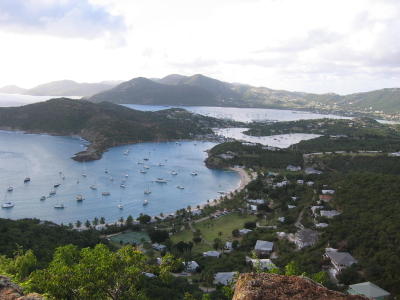 English Harbour viewed from Shirley Heights
English Harbour viewed from Shirley Heights

